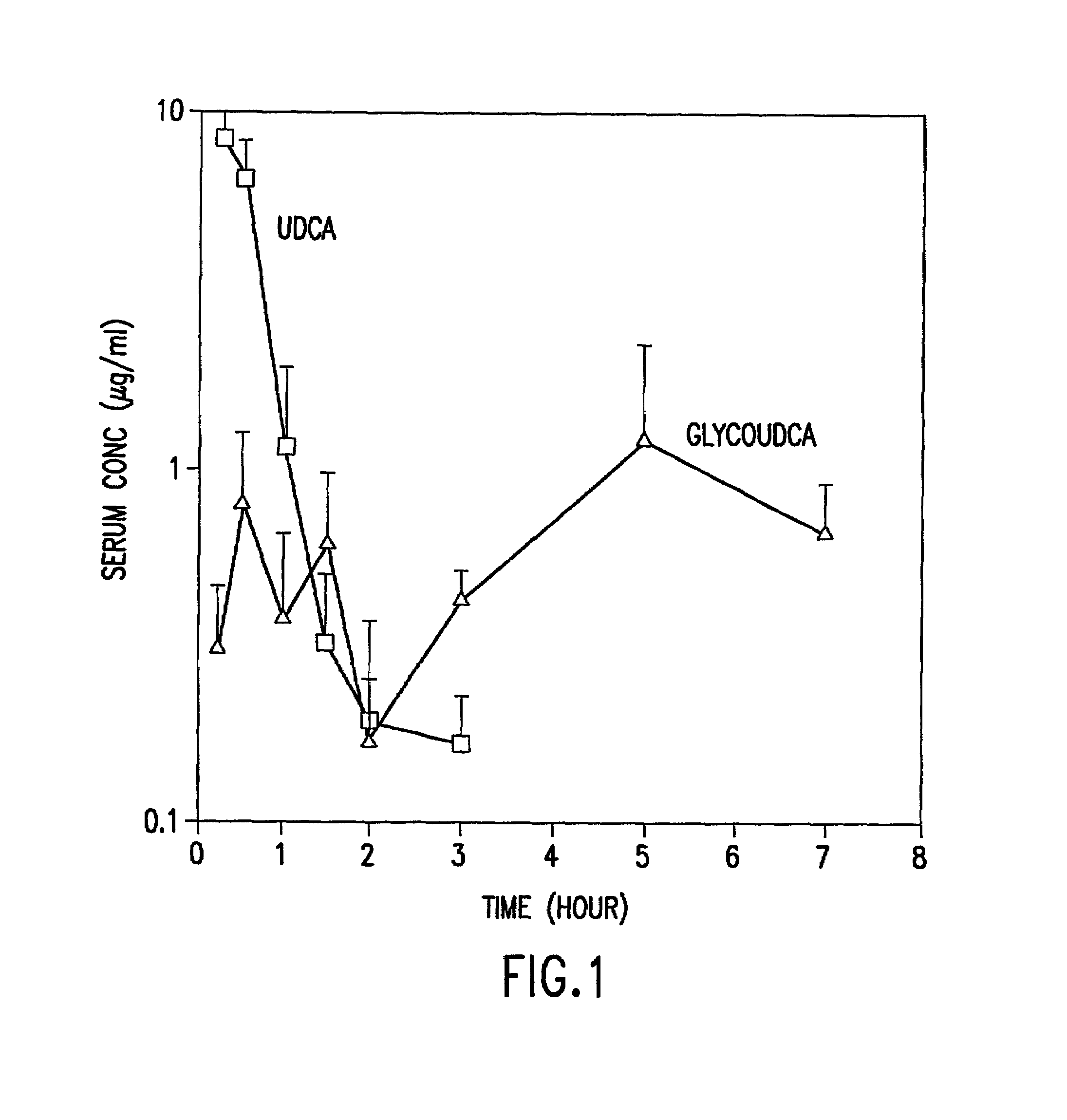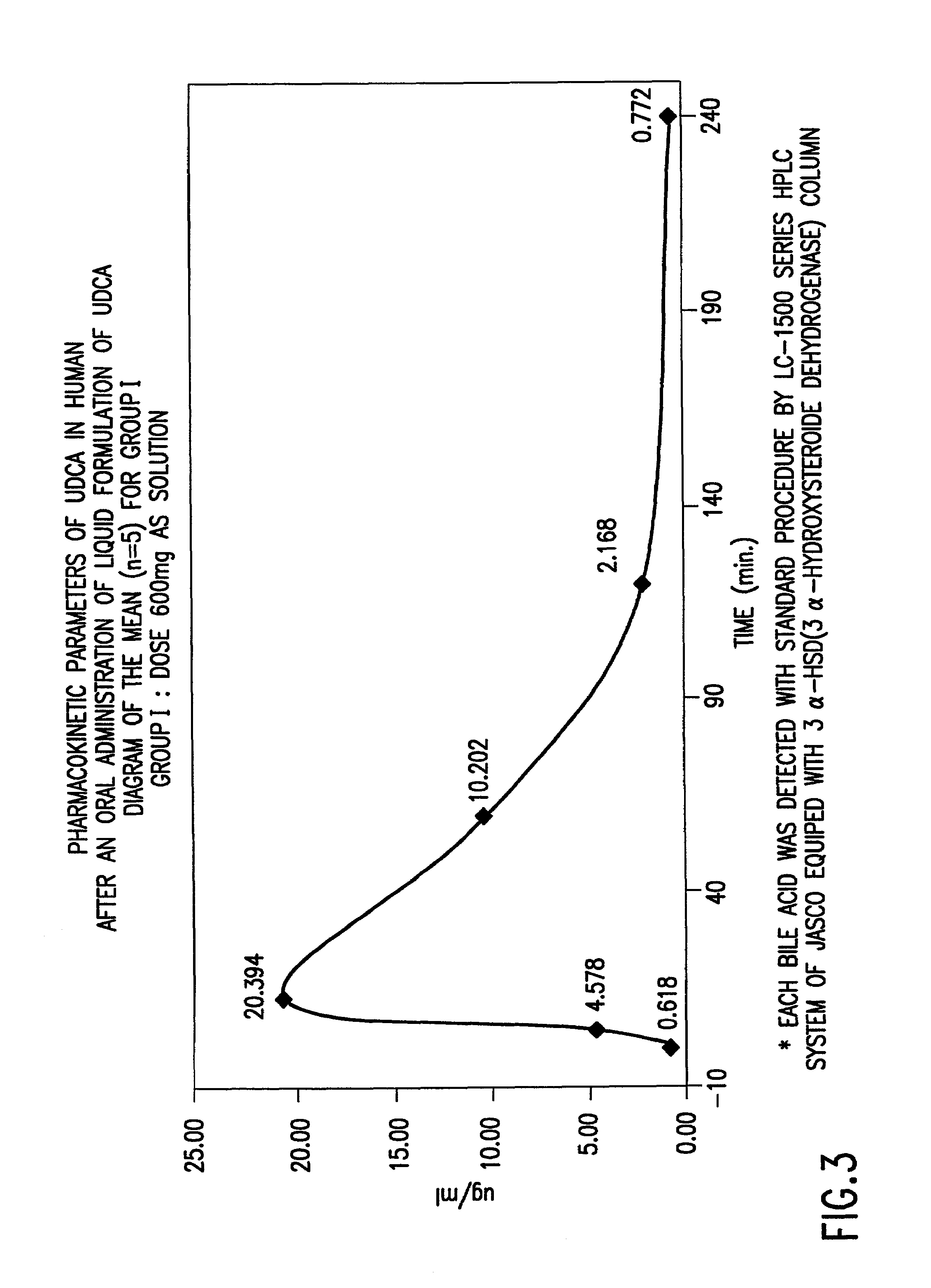Preparation of aqueous clear solution dosage forms with bile acids
a clear solution and aqueous technology, applied in the direction of biocide, dispersed delivery, drug composition, etc., can solve the problems of chemical and physical incompatibility of bile acid salts and insulin, unable to develop and commercialize revolutionary nasal spray solution dosage forms with bile acids as adjuvants, and unable to meet the needs of patients, so as to reduce toxicity and/or side effects, improve the intensity of response to or efficacy of pharmaceuticals, and alter the absorption of pharmaceuticals
- Summary
- Abstract
- Description
- Claims
- Application Information
AI Technical Summary
Benefits of technology
Problems solved by technology
Method used
Image
Examples
examples
[0095]The stability of dosage formulations of the invention were evaluated by measuring the concentration of the relevant bile acid over time in preparations comprising soluble bile acid, a high molecular weight aqueous soluble starch conversion product, and water at various pH and temperature levels. The retention time of each bile acid may be adjusted as needed to permit individual analysis each bile acid present in a complex samples, i.e. a sample having a plurality of bile acids.
[0096]The stability tests were conducted on three different aqueous solution systems:[0097]1. A bile acid and a high molecular weight aqueous soluble starch conversion product were combined in aqueous solution according to Example I, with results as shown in Tables 1A and 1B.[0098]2. Mixed bile acids and high molecular weight aqueous soluble starch conversion products were combined in aqueous solution according to Example II, with results as shown in Table 2.[0099]3. Bile acids, high molecular weight aqu...
example i
[0104]Solution dosage forms that were prepared according to the following guidelines did not show any precipitation at any pH tested.
[0105]
Soluble bile acid200 mg (as free acid)Minimal quantity of maltodextrinfor CDCA: approx. 30 g;for UDCA: approx. 5 g;for 7-ketolithocholic acid: approx.12 g;for cholic acid: approx. 10 g;for deoxycholic acid: approx. 50 g;for hyodeoxycholic acid: approx.3.5 gPurified water to make100 mL
[0106]100 mL of the aqueous solution in which one of the above bile acids is dissolved was prepared. Into the resulting clear solution, maltodextrin, a high molecular weight aqueous soluble starch conversion product, was added with agitation at room temperature. Purified water was added to adjust the total volume to be 100 mL. According to the instant invention and all examples, purified water is deionized, distilled deionized-distilled water, or a grade commonly used for pharmaceutical preparations.
[0107]Based on these formulas, the aqueous solution dosage forms of ...
example ii
[0108]Solution dosage forms that were prepared according to the following guidelines did not show any precipitation at any pH tested.
[0109]
Soluble cholic acid200 mg (as free acid),Soluble 7-ketolithocholic acid200 mg (as free acid),Soluble chenodeoxycholic acid200 mg (as free acid),Minimal quantity of maltodextrin40 g, andPurified water to make100 mL
[0110]60 mL of the aqueous solution in which soluble cholic acid, soluble 7-ketolithocholic acid, and soluble chenodeoxycholic acid are dissolved, was prepared. Into the resulting clear solution, maltodextrin was added with agitating at room temperature. Purified water was added to adjust the total volume to be 100 mL.
[0111]Using this formulation, the stability test for the aqueous solution of the mixture of various bile acids which can control the hydrophillicity or hydrophobicity was conducted.
[0112]Table 1A shows the results of a test of stability over time at pH 7 and 50° C. of formulations of CA, 7-ketolithocholic acid, CDCA and DCA...
PUM
| Property | Measurement | Unit |
|---|---|---|
| pKa | aaaaa | aaaaa |
| pKa | aaaaa | aaaaa |
| pH | aaaaa | aaaaa |
Abstract
Description
Claims
Application Information
 Login to View More
Login to View More - R&D
- Intellectual Property
- Life Sciences
- Materials
- Tech Scout
- Unparalleled Data Quality
- Higher Quality Content
- 60% Fewer Hallucinations
Browse by: Latest US Patents, China's latest patents, Technical Efficacy Thesaurus, Application Domain, Technology Topic, Popular Technical Reports.
© 2025 PatSnap. All rights reserved.Legal|Privacy policy|Modern Slavery Act Transparency Statement|Sitemap|About US| Contact US: help@patsnap.com



